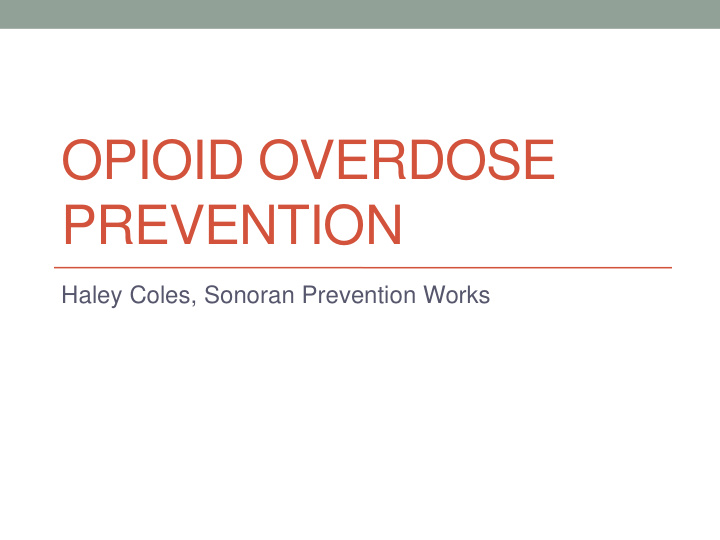



OPIOID OVERDOSE PREVENTION Haley Coles, Sonoran Prevention Works
What is an opioid? • Heroin • Prescription opioids (licit and illicit use) • Hydrocodone (Vicodin) • Oxycodone (Oxycontin, Percocet) • Hydromorphone (Dilaudid) • Morphine • Methadone • Fentanyl • Codeine • Rx opioids kill at least 3x as many Arizonans as heroin
What is an opioid overdose? • Opioids attach to receptor sites in brain, slows down body functions • Respiratory function slows until it fails • 4 minutes after respiratory failure, permanent brain damage & death • Fatality usually occurs 1-3 hours after opioid ingestion
Arizona Overdose Crisis • 2008 – Poisoning deaths surpassed motor vehicle deaths • 65% increase in overdose deaths in past 15 years • 1099 fatal overdoses in 2013 – 89% of all poisoning deaths • 6 th highest overdose fatalities in country in 2012 • Hospitalization for unintentional poisoning (94% drug related) cost Arizonans over $272 million in 2013, a 54% increase from 2012
Fatalities: overdose > motor accidents
Who is dying?
• Age: 45-54, followed by 55-64 • Race: • By age-adjusted rate: Native American and White • By number: White (899) and Hispanic (191) • Counties: Rural • 2013 counties with highest poisoning death rates, in order: Navajo, Coconino, Yavapai, Mohave, La Paz
Nonfatal overdose • Among all manners of non-fatal poisoning-related inpatient hospitalization, 94 percent were due to overdoses of a drug or medication • Hospitalization for unintentional poisoning cost Arizonans over $272 million in 2013, a 54% increase from 2012
4 out of 10 • 2013 Trust For America’s Health scored each state’s “promising strategies” for curbing prescription drug abuse • Arizona, along with Alabama, Kansas, Pennsylvania, Wisconsin, Wyoming • Missouri, Nebraska, South Dakota only states scoring less than AZ • http://healthyamericans.org/reports/drugabuse2013/releas e.php?stateid=AZ
Solutions • PDMP • Prescriber and patient education • Expanding treatment options (1 in 10 Americans with a substance use disorder receives treatment) • Medicaid expansion • Evidence-based treatment vs. other models • Harm Reduction • Syringe service programs • Good Samaritan law • Naloxone accessibility
Harm Reduction • Not using opioids is the greatest defense against overdose. Not a realistic or permanent solution for many. • Harm reduction is a set of practical strategies and ideas aimed at reducing negative consequences associated with drug use. • Accepts, for better or worse, that licit and illicit drug use is a part of our world, and works to minimize the harmful effects rather than simply ignore or condemn them; at the same time, harm reduction does not attempt to minimize or ignore the real & sometimes tragic harm and danger associated with licit and illicit drug use.
Treatment • Opioid Substitution Therapy (OST) – methadone, buprenorphine (suboxone) combined with psychosocial counseling • OST a more effective treatment than abstinence-based overall • OST most effective in reducing illicit substance use and overdose deaths • Oftentimes not accepted by DCS or drug courts
Syringe Service Programs • Decrease HIV & Hepatitis infections • Overdose prevention education/naloxone distribution is common • Opportunities to hear about laced or otherwise strong heroin, patterns of overdoses • Often a conduit to treatment services
Good Samaritan 911 law • Heart attack analogy • Prioritizes saving lives over arrests • Provides certain protections for the 911 caller and overdose victim – usually protection from possession/paraphernalia arrest/prosecution • 25 states as of December 2014 • WA study, drug users more likely to call 911 • 58-86% of heroin-related overdoses occur in the company of other people (Am. Journal Pub Health) • 911 is called only 10-56% of the time (AJPH) • Recommended by: ONDCP, CDC, AMA, APHA
Naloxone • How does naloxone reverse an overdose? • Safe, effective, easy to use • No side effects • Proven effective in pre-hospital setting • Essential for rural communities & those who can’t/won’t call 911 • Used by parents, EMTs, law enforcement, friends, and drug users
Naloxone • 28 other states (southern Red states, too) • Co-prescribing • CDC: over 10,000 successful overdose reversals in 15 years by drug users • Community programs • Over the counter in some states • Is it a barrier to treatment? • Recommended by ONDCP, AMA, APHA, CDC, SAMHSA • Why don’t we have this in AZ?
What does AZ need to do? • Encourage opioid substitution therapy when appropriate • Law to provide protections for prescribers and administrators layperson naloxone access • Good Samaritan 911 law increased calling for help • Authorize syringe distribution provides settings for drug users to learn about overdose prevention • Destigmatize drug users
Haley Coles hcoles@spwaz.org 602-388-9870 www.spwaz.org
Recommend
More recommend